Johannesburg ( joh-HAN-iss-burg, US also -HAHN-, Afrikaans: [jʊəˈɦanəsbœrχ]; Zulu and Xhosa: eGoli [ɛˈɡɔːli]) (colloquially known as Jozi, Joburg, Jo'burg or "The City of Gold") is the most populous city in South Africa with 4,803,262 people, and is classified as a megacity; it is one of the 100 largest urban areas in the world. It is the provincial capital and largest city of Gauteng, which is the wealthiest province in South Africa. Johannesburg is the seat of the Constitutional Court, the highest court in South Africa. Most of the major South African companies and banks have their ...Read more
Johannesburg ( joh-HAN-iss-burg, US also -HAHN-, Afrikaans: [jʊəˈɦanəsbœrχ]; Zulu and Xhosa: eGoli [ɛˈɡɔːli]) (colloquially known as Jozi, Joburg, Jo'burg or "The City of Gold") is the most populous city in South Africa with 4,803,262 people, and is classified as a megacity; it is one of the 100 largest urban areas in the world. It is the provincial capital and largest city of Gauteng, which is the wealthiest province in South Africa. Johannesburg is the seat of the Constitutional Court, the highest court in South Africa. Most of the major South African companies and banks have their head offices in Johannesburg. The city is located within the mineral-rich Witwatersrand hills, the epicentre of the international-scale mineral, gold and (specifically) diamond trade.
Johannesburg was established in 1886, following the discovery of gold, on what had been a farm. Due to the extremely large gold deposits found along the Witwatersrand, within ten years, the population had grown to over 100,000 inhabitants. A separate city from the late 1970s until 1994, Soweto is now part of the Greater Johannesburg metropolitan area. An acronym for "South-Western Townships", Soweto was organised initially as a collection of nondescript settlements on the outskirts of the city, populated mostly by African labourers working in the gold mining industry. Soweto, although eventually incorporated into Johannesburg, had been explicitly separated as a residential area for blacks only—no whites allowed—who were not permitted to live in other "white-designated" areas of Johannesburg. Another region, Lenasia, is predominantly populated by English-speaking Indo-South Africans (people of Indian and South Asian descent). These areas were, in previous decades, designated as non-white areas, in accordance with the segregationist policies of the time—known as apartheid. It would go on to be one of the host cities of the official tournament of the 2010 FIFA World Cup—and it hosted the final.
The metropolis is an alpha global city, as listed by the Globalization and World Cities Research Network. In 2019, the population of the city of Johannesburg was 5 635 127, making it the most populous city in South Africa. In the same year, the population of metro Johannesburg's urban agglomeration was put at 8 000 000. Land area of the municipal city (1,645 km2 or 635 sq mi) is large in comparison with those of other major cities, resulting in a moderate population density of 2,364 per square kilometre (6,120/sq mi).
The region surrounding Johannesburg was originally inhabited by San hunter-gatherers who used stone tools. There is evidence that they lived there up to ten centuries ago.[1] Stone-walled ruins of Sotho–Tswana towns and villages are scattered around the parts of the former Transvaal in which Johannesburg is situated.[2]
By the mid-18th century, the broader region was largely settled by various Sotho–Tswana communities (one linguistic branch of Bantu-speakers), whose villages, towns, chiefdoms and kingdoms stretched from the Bechuanaland Protectorate (what is now Botswana) in the west,[3] to present day Lesotho in the south,[4] to the present day Pedi areas of the Limpopo Province. More specifically, the stone-walled ruins of Sotho–Tswana towns and villages are scattered around the parts of the former Transvaal province in which Johannesburg is situated.
Many Sotho–Tswana towns and villages in the areas around Johannesburg were destroyed and their people driven away during the wars emanating from Zululand during the late 18th and early 19th centuries (the mfecane or difaqane wars),[citation needed] and as a result, an offshoot of the Zulu kingdom, the Ndebele (often referred to as the Matabele, the name given them by the local Sotho–Tswana), set up a kingdom to the northwest of Johannesburg around modern-day Rustenburg.
Gold rush and naming of the city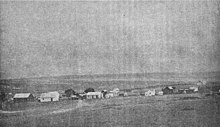 The Langlaagte farm near Paarlshoop, on the Witwatersrand – site of the first discovery of gold in 1886.
The Langlaagte farm near Paarlshoop, on the Witwatersrand – site of the first discovery of gold in 1886. Ferreirasdorp gold mine in 1886, the oldest part of Johannesburg[5][6] and where the first gold diggers initially settled.[7]
Ferreirasdorp gold mine in 1886, the oldest part of Johannesburg[5][6] and where the first gold diggers initially settled.[7]The main Witwatersrand gold reef was discovered in June 1884 on the farm Vogelstruisfontein by Jan Gerritse Bantjes, son of Jan Bantjes, this triggered the Witwatersrand Gold Rush and the founding of Johannesburg in 1886. The discovery of gold rapidly attracted people to the area, making necessary a name and governmental organisation for the area. Jan, Johan and Johannes were common male names among the Dutch of that time; two men involved in surveying the area for the best location of the city, Christian Johannes Joubert and Johann Rissik, are considered the source of the name by some. Johannes Meyer, the first government official in the area is another possibility. Precise records for the choice of name were lost.[8] Within ten years, the city of Johannesburg included 100,000 people.[9]
In September 1884, the Struben brothers discovered the Confidence Reef on the farm Wilgespruit near present-day Roodepoort, which further boosted excitement over gold prospects.[10]: 254 The first gold to be crushed on the Witwatersrand was the gold-bearing rock from the Bantjes mine crushed using the Struben brothers stamp machine. News of the discovery soon reached Kimberley and directors Cecil Rhodes and Sir Joseph Robinson rode up to investigate the rumours for themselves. They were guided to the Bantjes camp with its tents strung out over several kilometres and stayed with Bantjes for two nights.[citation needed]
In 1884, they purchased the first pure refined gold from Bantjes for £3,000. Incidentally, Bantjes had from 1881 been operating the Kromdraai Gold Mine in the Cradle of Humankind together with his partner Johannes Stephanus Minnaar where they first discovered gold in 1881, and which also offered another kind of discovery—the early ancestors of all mankind.[citation needed] Some report Australian George Harrison as the first to make a claim for gold in the area that became Johannesburg, as he found gold on a farm in July 1886. He did not remain in the area.[11]
Gold was earlier discovered some 400 kilometres (249 miles) to the east of present-day Johannesburg in Barberton. Gold prospectors soon discovered the richer gold reefs of the Witwatersrand offered by Bantjes. The original miners' camp, under the informal leadership of Col Ignatius Ferreira, was located in the Fordsburg dip, possibly because water was available there, and because of the site's proximity to the diggings. Following the establishment of Johannesburg, the area was taken over by the Transvaal government who had it surveyed and named it Ferreira's Township, today the suburb of Ferreirasdorp. The first settlement at Ferreira's Camp was established as a tented camp and which soon reached a population of 3,000 by 1887.[9] The government took over the camp, surveyed it and named it Ferreira's Township.[12] By 1896, Johannesburg was established as a city of over 100,000 inhabitants, one of the fastest growth cities ever.[9]
Mines near Johannesburg are among the deepest in the world, with some as deep as 4,000 metres (13,000 ft).[13]
Rapid growth, Jameson Raid and the Second Boer War Johannesburg in 1889
Johannesburg in 1889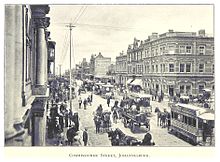 Commissioner Street in 1895
Commissioner Street in 1895Like many late 19th-century mining towns, Johannesburg was a rough and disorganised place, populated by white miners from all continents, African tribesmen were recruited to perform unskilled mine work, African women beer brewers cooked for and sold beer to the black migrant workers, a very large number of European prostitutes, gangsters, impoverished Afrikaners, tradesmen, and the "AmaWasha", Zulu men who surprisingly dominated laundry work.[14] As the value of control of the land increased, tensions developed between the Boer–dominated Transvaal government in Pretoria and the British, culminating in the Jameson Raid that ended in fiasco at Doornkop in January 1896. The Second Boer War (1899–1902) saw British forces under Field Marshal Frederick Sleigh Roberts, 1st Earl Roberts, occupy the city on 30 May 1900 after a series of battles to the south-west of its then-limits, near present-day Krugersdorp.[citation needed]
Fighting took place at the Gatsrand Pass (near Zakariyya Park) on 27 May, north of Vanwyksrust—today's Nancefield, Eldorado Park and Naturena—the next day, culminating in a mass infantry attack on what is now the waterworks ridge in Chiawelo and Senaoane on 29 May.[15][16]
During the Boer war, many African mineworkers left Johannesburg creating a labour shortage, which the mines ameliorated by bringing in labourers from China, especially southern China. After the war, they were replaced by black workers, but many Chinese stayed on, creating Johannesburg's Chinese community, which during the apartheid era, was not legally classified as "Asian", but as "Coloured". The population in 1904 was 155,642, of whom 83,363 were whites.[17]
Post-Union history Pritchard Street c. 1910
Pritchard Street c. 1910In 1917, Johannesburg became the headquarters of the Anglo-American Corporation founded by Ernest Oppenheimer which ultimately became one of the world's largest corporations, dominating both gold-mining and diamond-mining in South Africa. Major building developments took place in the 1930s, after South Africa went off the gold standard.[citation needed] In the late 1940s and early 1950s, Hillbrow went high-rise. In the 1950s and early 1960s, the apartheid government constructed the massive agglomeration of townships that became known as Soweto. New freeways encouraged massive suburban sprawl to the north of the city.[citation needed] In the late 1960s and early 1970s, tower blocks (including the Carlton Centre and the Southern Life Centre) filled the skyline of the central business district.
Under the system of apartheid (Afrikaans for "apartness", or "separate development" although the system was founded by the British), a comprehensive system of racial separation was imposed upon South Africa starting in 1948. For its growth, the economy of Johannesburg depended upon hundreds of thousands of skilled white workers imported from Europe and semi- and un-skilled black workers imported from other parts of Southern Africa. Though they worked together they were forced by the government to live separately. Work was considered to be an exception to apartheid in order to keep Johannesburg functioning as South Africa's economic capital.[18]
 Stuttafords department stores in Johannesburg in 1957
Stuttafords department stores in Johannesburg in 1957In the 1950s, the government began a policy of building townships for black families (prior to this unskilled workers were asked to work on "single status" in male-only hostels at the mines and had to commute to see their families in whatever province they originated) outside of Johannesburg to provide workers for Johannesburg.[18] Soweto, a township founded for black workers coming to work in the gold mines of Johannesburg, was intended to house 50,000 people, but soon was the home of ten times that number as thousands of unemployed rural blacks came to Johannesburg for employment and an income to send back to their villages.[19] It was estimated that in 1989, the population of Soweto was equal to that of Johannesburg, if not greater.[19]
In March 1960, Johannesburg witnessed widespread demonstrations against apartheid in response to the Sharpeville massacre.[20] On 11 July 1963, the South African Police raided a house in the Johannesburg suburb of Rivonia where nine members of the banned African National Congress (ANC) were arrested on charges of planning sabotage. Their arrest led to the famous Rivonia Trial.[19] The nine arrested included one Indo-South African, one coloured, two whites and five blacks, one of whom was the future president Nelson Mandela.[21] At their trial, the accused freely admitted that they were guilty of what they were charged with, namely of planning to blow up the hydro-electric system of Johannesburg to shut down the gold mines, but Mandela argued to the court that the ANC had tried non-violent resistance to apartheid and failed, leaving him with no other choice.[21] The trial made Mandela into a national figure and a symbol of resistance to apartheid.[21]
 Street scene in Johannesburg in 1970
Street scene in Johannesburg in 1970On 16 June 1976, demonstrations broke out in Soweto over a government decree that black school-children be educated in Afrikaans instead of English, and after the police fired on the demonstrations, rioting against apartheid began in Soweto and spread into the greater Johannesburg area.[22] About 575 people, the majority of whom were black, were killed in the Soweto uprising of 1976.[20] Between 1984 and 1986, South Africa was in turmoil as a series of nationwide protests, strikes and riots took place against apartheid, and the black townships around Johannesburg were scenes of some of the fiercest struggles between the police and anti-apartheid demonstrators.[23]
The central area of the city underwent something of a decline in the 1980s and 1990s, due to the high crime rate and when property speculators directed large amounts of capital into suburban shopping malls, decentralised office parks, and entertainment centres. Sandton City was opened in 1973, followed by Rosebank Mall in 1976, and Eastgate in 1979.[24]
During the 1990s, the city faced rapid growth of crime throughout large parts of the city. Some areas of skyscrapers were abandoned, many residents left their homes, and businesses moved out. Some historical buildings in central areas were destroyed by fires that spread relentlessly.[25]
21st century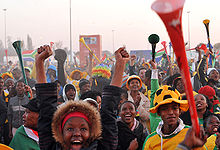 Fans of South Africa national soccer team watching the 2010 FIFA World Cup with vuvuzelas in the township of Soweto, a suburb of Johannesburg.
Fans of South Africa national soccer team watching the 2010 FIFA World Cup with vuvuzelas in the township of Soweto, a suburb of Johannesburg.Like many cities around the world, there is an increasing focus on the rejuvenation of the inner city of Johannesburg. One of these initiatives is the Maboneng District located on the south-eastern side of the CBD. Originally a hub for art, it has expanded to include restaurants, entertainment venues and retail stores as well as accommodation and hotels. Maboneng calls itself "a place of inspiration—a creative hub, a place to do business, a destination for visitors and a safe, integrated community for residents. A beacon of strength in Africa's most economically prosperous city".[26]
After being destroyed in 2008 to make way for a motor showroom by Imperial Holdings, the iconic Rand Steam Laundries are now being redeveloped as an exact replica, by the order of the Johannesburg Heritage Council. Apart from one filtration shed, there is nothing left on the site after being destroyed. The site will consist of a 5,000 m2 (54,000 sq ft) precinct.[27][28]
On 12 May 2008, a series of riots started in the township of Alexandra, in the north-eastern part of Johannesburg, when locals attacked migrants from Mozambique, Malawi and Zimbabwe, killing two people and injuring 40 others. These riots sparked the xenophobic attacks of 2008.[29] The 2019 Johannesburg riots were similar in nature and origin to the 2008 xenophobic riots.[30]
A completely refurbished Soccer City stadium in Johannesburg hosted the 2010 FIFA World Cup final.[31]
From 22 to 24 August 2023, Johannesburg hosted 15th BRICS Summit.[32]
On 31 August 2023, at least 76 people died when a building caught fire in Johannesburg. The building had been taken over by a gang who were illegally renting it out.[33]






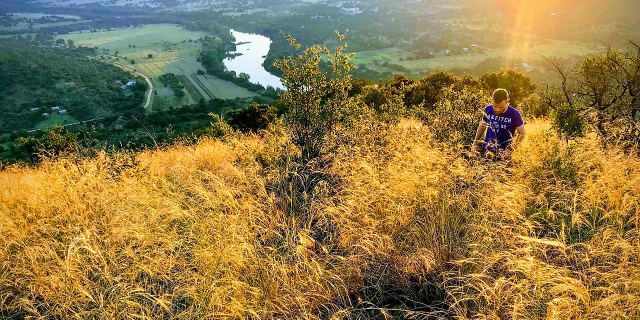



















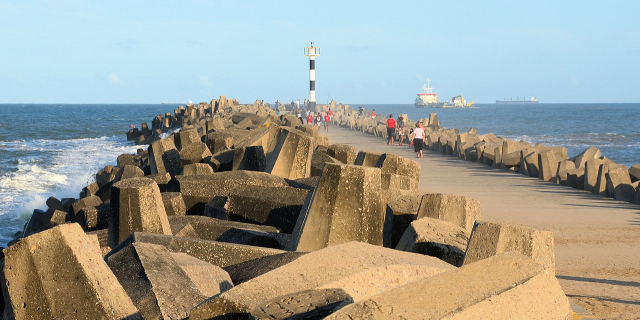




Add new comment